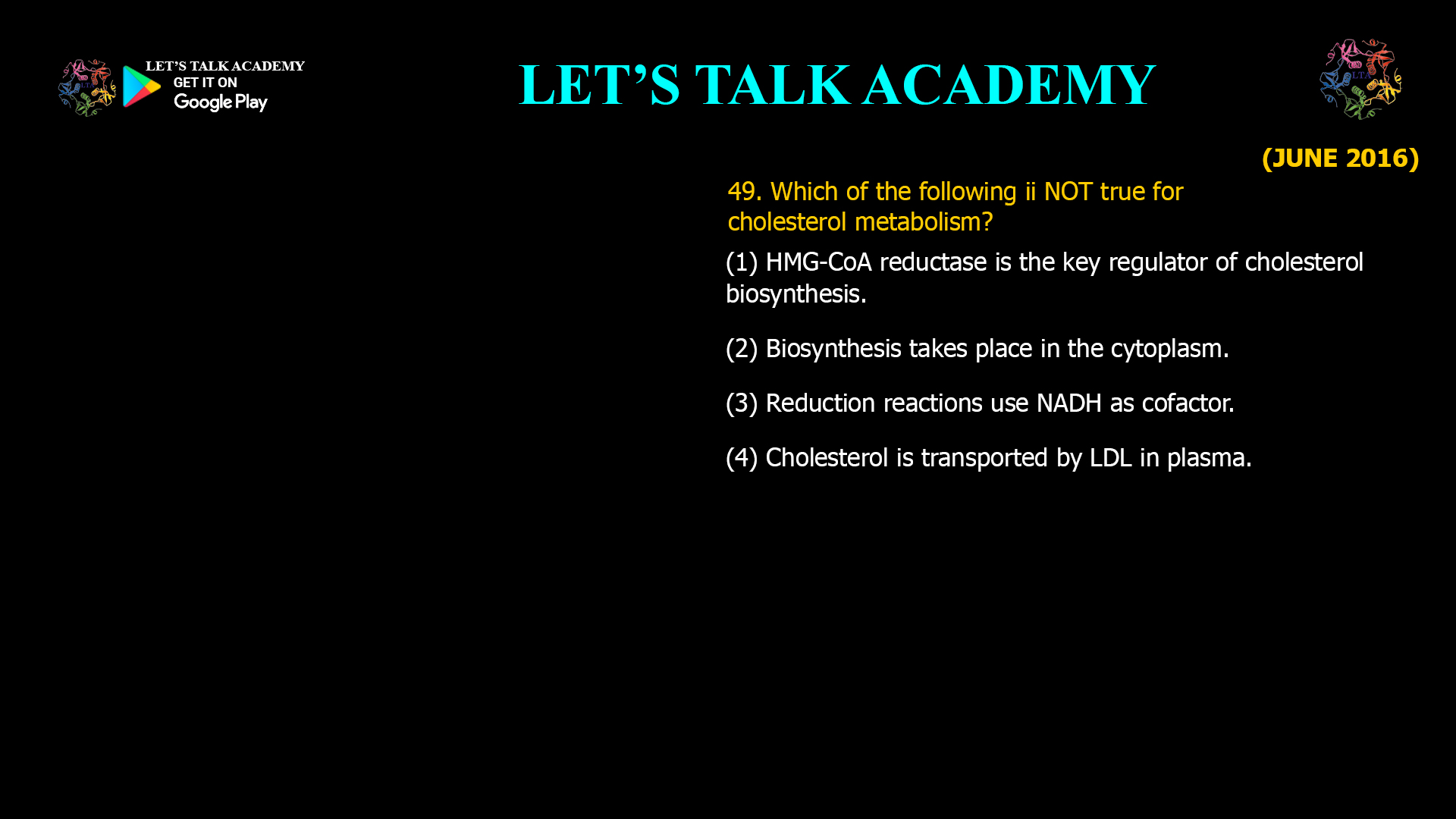- Which of the following ii NOT true for cholesterol metabolism?
(1) HMG-CoA reductase is the key regulator of cholesterol biosynthesis.
(2) Biosynthesis takes place in the cytoplasm.
(3) Reduction reactions use NADH as cofactor.
(4) Cholesterol is transported by LDL in plasma.
Cholesterol metabolism is a vital biochemical process that sustains cellular function, membrane integrity, and hormone synthesis. Several enzymes and pathways regulate cholesterol synthesis and transport, ensuring balance within the body. However, some misconceptions persist regarding the details of this metabolism.
This article clarifies key facts about cholesterol metabolism and identifies which statement among common beliefs is incorrect.
Key Facts About Cholesterol Metabolism
1. HMG-CoA Reductase: The Key Regulator of Cholesterol Biosynthesis
-
3-Hydroxy-3-methylglutaryl coenzyme A (HMG-CoA) reductase is the rate-limiting enzyme in cholesterol biosynthesis.
-
It catalyzes the conversion of HMG-CoA to mevalonate, a critical early step in the pathway.
-
This enzyme is tightly regulated by feedback mechanisms involving sterols and non-sterol isoprenoids.
-
Statin drugs target HMG-CoA reductase to lower cholesterol levels in patients with hypercholesterolemia.
2. Location of Cholesterol Biosynthesis
-
Cholesterol biosynthesis occurs primarily in the cytoplasm and endoplasmic reticulum of cells.
-
The early steps, including the formation of mevalonate, happen in the cytoplasm.
-
Later steps involving membrane-bound enzymes take place in the endoplasmic reticulum.
3. Cofactors Used in Reduction Reactions
-
The biosynthesis pathway involves multiple reduction reactions.
-
These reduction steps predominantly use NADPH (nicotinamide adenine dinucleotide phosphate) as the electron donor.
-
NADH is primarily involved in catabolic reactions (energy-yielding pathways) rather than anabolic processes like cholesterol synthesis.
4. Cholesterol Transport in Plasma
-
Cholesterol is transported in the bloodstream primarily by lipoproteins.
-
Low-density lipoprotein (LDL) carries cholesterol from the liver to peripheral tissues.
-
LDL is often referred to as “bad cholesterol” because high levels are associated with atherosclerosis.
-
High-density lipoprotein (HDL) transports cholesterol back to the liver for excretion or recycling.
Evaluating the Statements
Statement Truthfulness Explanation (1) HMG-CoA reductase is the key regulator of cholesterol biosynthesis. True Well-established fact in cholesterol metabolism. (2) Biosynthesis takes place in the cytoplasm. True (partially) Early steps occur in cytoplasm; later steps in ER membranes. (3) Reduction reactions use NADH as cofactor. False Reduction reactions in cholesterol synthesis use NADPH, not NADH. (4) Cholesterol is transported by LDL in plasma. True LDL is the main cholesterol carrier to tissues. Why Statement (3) Is Not True
-
Cholesterol biosynthesis is an anabolic process requiring reducing power.
-
The reducing equivalent used is NADPH, generated mainly by the pentose phosphate pathway and malic enzyme.
-
NADH is predominantly involved in catabolic pathways such as glycolysis and the TCA cycle.
-
Therefore, stating that NADH is the cofactor for reduction reactions in cholesterol biosynthesis is incorrect.
Summary
Cholesterol metabolism involves:
-
Regulation by HMG-CoA reductase, the rate-limiting enzyme.
-
Biosynthesis largely occurring in the cytoplasm and endoplasmic reticulum.
-
Reduction reactions utilizing NADPH, not NADH, as the reducing cofactor.
-
Transport of cholesterol in plasma mainly via LDL particles.
Conclusion
Among the statements given about cholesterol metabolism, the incorrect one is:
(3) Reduction reactions use NADH as cofactor.
The correct cofactor for these biosynthetic reduction reactions is NADPH.
-




14 Comments
Kirti Agarwal
September 19, 2025Reduction reaction use NADP as cofactor is incorrect statement
Bhawna Choudhary
September 21, 2025Reduction reactions use NADH as cofactor.
Savita Garwa
September 21, 2025Reduction reactions use NADH as cofactor
Priya dhakad
September 23, 2025The correct cofactor for these biosynthetic reduction reactions is NADPH so 3 option is correct
Pallavi Ghangas
September 23, 2025reductase reaction use nadph as Co factor
Aakansha sharma Sharma
September 23, 2025Reduction reaction use NADP as cofactor is incorrect statement
Priti khandal
September 24, 2025Reduction reaction use NADP as cofactor is incorrect statement
Mohd juber Ali
September 25, 2025Reduction reactions in cholesterol synthesis use NADPH, not NADH.
Muskan singodiya
September 25, 2025Reduction reaction use nadp as cofactor
Varsha Tatla
September 27, 2025Reduction reaction use NADPH not NADH as a co factor
Kajal
October 1, 2025NADPH is used
Muskan Yadav
October 3, 2025(3) Reduction reactions use NADH as cofactor.
The correct cofactor for these biosynthetic reduction reactions is NADPH.
Santosh Saini
October 5, 2025Statement 3 is incorrect because Reduction reaction in cholesterol synthesis use NADPH , not NADH
Khushi Vaishnav
October 7, 2025Reduction reactions in cholesterol synthesis uses NADPH as cofactor not NADH